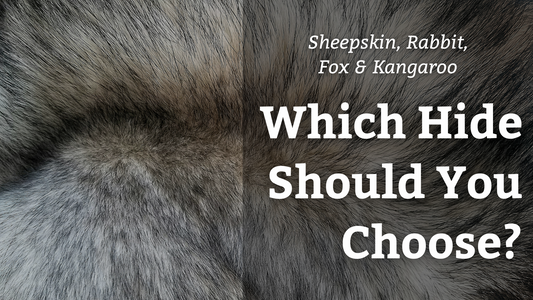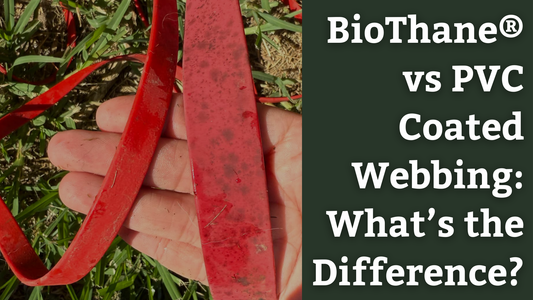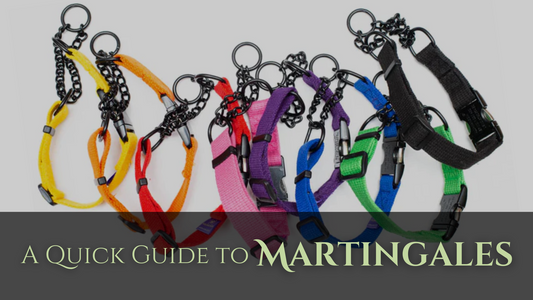So, you got a new dog! While super fun and exciting, the early stages of dog ownership can also be stressful. Not just with knowing what tools and supplies you need, but learning to manage your dog in new and unfamiliar environments is always something of a test. A good chunk of this stress can be alleviated by the use of a long dog training lead, which happens to be our favourite shortcut to teaching recall.
Most standard leashes will fall between 1.2-1.8m in length, but long lines will usually run anywhere from about 3-10m in length, giving your dog that extra room to explore with the safety of a leash. They still come in a variety of materials, from cotton webbing and BioThane, to leather or a piece of rope!

Choosing the Right Long Lead for Your Dog
So, which one is the right long lead for your dog? On our site alone you have the choice of a puppy (light) or adult (standard) and multiple length options for each weight, as well as a Beta Rope option. Personally, we do this to ensure that everyone can find a long leash that suits their dog and their needs.
If your dog is small of stature (young puppies, petite or toy breeds), then you can go for our lightweight line. If your dog is 20kg or more, then we highly suggest going for the standard weight. The leash length will more or less depend on how and where you intend to use it most. BioThane is a great choice for versatility, as it can handle sand, dirt, water and mud with ease. However, keep an eye on our socials as we’ll be bringing out cotton webbing long lines soon!
Why Use a Long Leash for Training Your Dog’s Recall?
One of the best uses for a long leash is training recall! It’s an effective tool that ensures your dog cannot ignore the recall command while you’re still training. This helps the dog learn recall faster, and the sooner the both of you can enjoy off-leash time with confidence.
Many inexperienced dog owners may not appreciate the importance of a good recall until they’re in a situation where they need it most. Even if you never intend to have your dog off-leash, it’s far too easy to be caught off guard. Your dog might spy a small animal, another dog or even get spooked and suddenly they’ve bolted and the leash slips right out of your hand. The ability to confidently recall your dog back in such situations can sometimes be a matter of life or death for your dog, or any other person/animal involved!

How to Train Recall
Okay, so you’ve got your regular leash and a long leash and you’re ready to do some dog training. This is our preferred method for training recall using a long lead – of course you can use any leash or even a length of rope if you like, but as you surely know by now, at Wildhunde, we personally prefer a BioThane long line so you can train essentially anywhere without needing to deal with a sandy, dirty, muddy or snagged leash.
As with any new training exercise, it’s usually best to begin in a safe and familiar environment. For teaching recall, we suggest starting in your backyard where your dog is most comfortable. It won’t be until your dog has some understanding and consistency in recall that we’ll start practicing elsewhere, in more challenging or distracting environments.
For now though, make sure that the environment is distraction-free! If there are other dogs or kids or other cool exciting things going on, it’ll be difficult for your dog to focus on what you’re trying to teach. As with most training exercises, food reward is a quick and effective motivator – choose a treat that your dog loves. We want your dog willing to do anything for the goods!
Step One
For the initial steps, a regular length leash will be more effective as you will be moving with your dog.
- Hold a delicious morsel to your dog’s nose (he can smell it, he wants it!). Then in a clear and enthusiastic voice, say “Come!” and begin to move backwards, inviting the dog to follow you. Use a fun and upbeat voice so that your dog is excited to follow you! (This can be any gibberish you want, as long as it sounds FUN).
- Move back a short distance and as your dog follows, mark the action with praise and give your dog multiple rewards as you continue to move backwards!
Repeat this step at least 3-5 times so your dog gets the hang of it.
Step Two
For this step you’ll need a helper! Your helper will need to restrain an excited dog, so choose wisely 😀
- Have your helper restrain your dog by the leash or collar, and keep a firm grip. Using your reward of choice, tease your dog with the treat but do not give any yet!
- Turn and run away a bit further than the previous step (e.g. from one end of the yard to the other). Now face your dog and call “Come!” (again making sure to use that same fun voice).
- The helper now releases the dog, and if all goes well, your dog should pretty much slingshot towards you. Remember to wail as much happy nonsense as possible to keep the excitement high! We are teaching the dog that coming back to you is LITERALLY the best thing ever! Once your dog arrives, reward reward reward!
Repeat at least 3-5 times, until you have consistent results.

Step Three
As with Step Two, have your dog held firmly by your helper.
- This time after you tease and run away, make your dog wait. Keep it variable but anywhere from 3-10 seconds is a good window to keep them anticipating. Then call “Come!”, followed by a big happy voice to keep them in that excited state.
- When your dog arrives, reward reward reward! This is important because we don’t want just the act of coming back to be rewarding, we are also rewarding them for sticking around! It’s not much use if your dog comes to you only to run away immediately again.
- After you’ve rewarded your dog for sticking close, give a release so they get a little bit of free time before you start over.
Repeat at least 5-10 times.
By this point, you should be starting to see your dog not just understand the command but be eager for it. They’ve learned that if they come, they not only get a delicious treat, but they get all that energetic praise and hype from you, and afterwards they get to go back to whatever they were doing before. It’s a win-win for them!
Essentially, we’re ensuring that whatever has your dog’s attention in the future will never be as enticing as the recall command because coming back to you is just like, the best and most amazing thing ever!
Step Four
Now is the point at which we start to space out the immediate rewards. Instead of keeping a handful of treats ready to feed; keep them in your pocket or a treat pouch.
- Do not tease with the treat before you run away, and start to increase the distance you’re making. Call “Come!” using variable pauses (anywhere from 3-30 seconds, keep it random) but still use an energetic voice when they come.
- If you’re struggling with the transition from the previous step to this one, then revert back to Step Three and repeat a few more times before trying Step Four again.
Repeat 5-10 times, and as you progress, start to bring your high-energy voice back down to earth.
Step Five
Proceed as before, but this time when you run away, move somewhere out of sight. Into another room, behind the shed, wherever you can – as long as the dog no longer has a direct line of sight to you.
- Change it up each time so your dog isn’t just heading for a location – they're heading specifically to you.
- Really start to lessen that happy excited voice – sometimes you praise and cheer, sometimes you don’t. The dog is no longer dependent on your happy voice for his eagerness to come to you!
When you’re ready, move to step six to make it more challenging for your dog!
Step Six
This time when you hide, call “Come!” and then stay silent! Once he finds you, reward with a quick game of tug, or other exciting affection like pats and belly rubs.
Repeat as often as you feel necessary, while continuing to vary the pattern.
Step Seven
This is the final stage. ONLY proceed to this stage when you feel your dog has truly got the grasp of how amazingly rewarding and fun recall is. Your dog must be able to respond to recall joyfully and without fail every time before you can start introducing external distractions. This can take at least two weeks, if not more!
If they cannot do it reliably in a familiar and distraction-free environment, then how can we expect them to do so while all senses are being assaulted by all the exciting wonders of the great outdoors? If you feel that your dog is ready for the next level, then with a long leash in hand; proceed!
- Take your dog somewhere new with some mild distractions. An open park or sports oval with little to no traffic is always a great option. Do not go to a dog park! Put your dog on the long leash, and let them have a sniff around first to get the novelty out of the way.
- Starting with a high-value treat, we start the process again from steps 2-6. Repeat steps or progress as your dog needs.
The long line ensures that you can control the distance your dog can travel, which is especially important when you’re in an open or different location. It also ensures that if your dog is too distracted to obey the recall command, you can use the leash to reel them in and remind them that recall is not actually optional!
Repeat and Reward!
As time goes on, it’s always good to repeat and reinforce recall training. If you feel that your dog has a confident and consistent grasp of recall in most situations, you can start introducing some more challenging scenarios where they may be sorely tempted to ignore the command (e.g. put them on a long leash and let them ‘escape’ out the front door, and then recall and reward). This helps protect you and your dog from unexpected and potentially dangerous situations, as your dog will always be more excited to run back to you rather than see what else is out there.
It’s also important to ensure that “Come” is always a positive experience for your dog! If you recall the dog only to punish, or only to signal the end of an outing – your dog is less likely to come.
Remember that your dog needs to feel that coming back to you is always the rewarding decision. You can continue to reward them with treats, tug, or a simple praise and release, so they can back to the fun times. Regardless, it has to be worth it for them to come back.

At the end of the day, long lead training with your dog will ensure a safe, positive and solid recall. When you and your dog are well and truly ready, you can decide to practice going off lead – but don’t feel pressured to do so. Continue training your dog on the long leash as long as you feel necessary; there’s no one timeline for any dog!
For any dogs with reactivity or other behavioural concerns, we highly recommend working with a qualified professional in order to modify a training approach that best suits the needs of your dog. If you’re not sure where to turn, we’ll be more than happy to point you in the direction of an experienced and trusted trainer in your local area.




